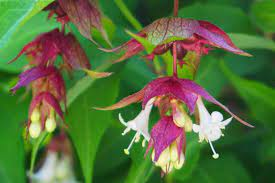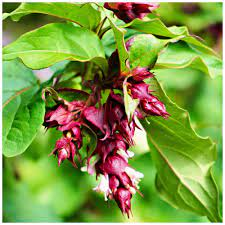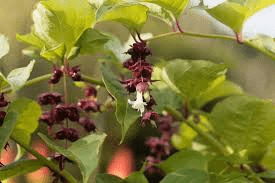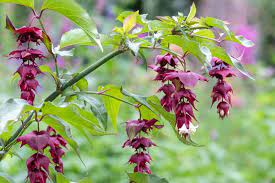Leycesteria formosa, commonly known as Himalayan Honeysuckle, is an ornamental shrub that belongs to the Caprifoliaceae family. Native to the Himalayan region, this deciduous plant is appreciated for its distinctive and attractive features.
Himalayan Honeysuckle is known for its arching stems, reaching heights of 1.5 to 2.5 meters, and its striking pendulous racemes of flowers, followed by clusters of berries. The leaves are opposite, ovate to lanceolate, and can be dark green or purplish.
The flowers of Leycesteria formosa are noteworthy for their unique appearance. The dangling racemes consist of tubular, white to pale pink flowers, often surrounded by dark purple bracts, creating an eye-catching display.
Following the flowering period, the plant develops berries that start green and transition through shades of purple, eventually turning dark purple or black when ripe.
Himalayan Honeysuckle is valued in horticulture for its ornamental qualities, making it a popular choice in gardens and landscapes. It is well-suited to a variety of soil types and can tolerate partial shade, making it adaptable to different growing conditions.
The plant is also appreciated for its ability to attract pollinators, such as butterflies and bees, adding ecological value to garden spaces.
Beyond its ornamental use, there is limited traditional medicinal use associated with Leycesteria formosa. However, it’s primarily cultivated for its aesthetic appeal and landscape enhancement.
Gardeners often appreciate its relatively low maintenance requirements and its ability to thrive in diverse climates.
As with any plant, it’s important to consider the specific growing conditions and local regulations before introducing Himalayan Honeysuckle to a new environment.
Its non-invasive nature, coupled with its aesthetic attributes, makes it a welcome addition to gardens in many regions where it can be successfully cultivated.
The Botanical Description of Leycesteria formosa
1. Habit and Growth: Leycesteria formosa, commonly known as Himalayan honeysuckle or Pheasant Berry, is a deciduous shrub known for its graceful and arching growth habit, reaching a height of 6 to 10 feet.
2. Leaves: The leaves of Leycesteria formosa are opposite, simple, and green, with a distinct ovate shape and serrated edges, providing an attractive foliage display throughout the growing season.
3. Flowers: The plant produces pendulous clusters of tubular flowers with deep purple bracts, adding to the overall aesthetic appeal. The bloom period typically occurs in late spring to early summer.
4. Fruit: Leycesteria formosa bears small, round berries that start as green and transform into deep purple when ripe, known for their sweetness and ornamental value.
5. Stem and Bark: The stems are hollow, giving them a distinct quality, and the bark is relatively smooth, ranging from reddish-brown to gray, contributing to the overall visual interest.
6. Root System: Leycesteria formosa has a fibrous root system, aiding in its adaptability to different soil conditions and making it suitable for cultivation in various garden settings.
7. Native Habitat: Native to the Himalayas, including Nepal and southwestern China, the shrub thrives in temperate climates and has shown adaptability to different environmental conditions.
8. Foliage Texture: The medium-textured foliage creates a balanced visual effect when planted alongside other ornamental plants.
9. Fragrance: While not known for a strong fragrance, the flowers emit a subtle, pleasant scent, contributing to the overall sensory experience.
10. Seasonal Changes: As a deciduous shrub, Leycesteria formosa undergoes seasonal changes. In autumn, the leaves turn shades of red and purple before falling, providing a final burst of color before winter dormancy.
The Geographic Distribution of Leycesteria formosa

1. Himalayan Region: Predominantly found in the Himalayan region, including Nepal, Bhutan, and India, where it thrives in mountainous landscapes.
2. China: Native to southwestern China, Leycesteria formosa is found in diverse habitats ranging from forests to open hillsides.
3. Naturalized in Europe: Beyond its native range, the shrub has been introduced and naturalized in various parts of Europe, often cultivated for its ornamental value in gardens.
4. Cultivation in North America: Due to its hardiness and attractive features, Leycesteria formosa has been cultivated in North America, particularly in temperate regions.
5. Garden and Landscape Use: Adopted for ornamental purposes worldwide, its adaptability to different climates and soils contributes to its popularity in gardens and landscapes.
6. Parks and Botanical Gardens: Leycesteria formosa can often be found in parks and botanical gardens, where its aesthetic qualities are showcased, adding to biodiversity.
7. Altitude Range: The geographic distribution spans a range of altitudes, from lower elevations to subalpine regions, allowing it to thrive in various ecological niches.
8. Presence in Woodlands: Frequently found in woodlands in its native habitats, the arching growth habit and distinctive flowers contribute to ecosystem diversity.
9. Gardens and Urban Landscapes: Leycesteria formosa is a popular choice for urban landscaping, thanks to its adaptability to different soil conditions and pollution.
10. Conservation Status: While not currently listed as endangered, conservation efforts may be needed to protect its natural habitats and genetic diversity.
The Chemical Composition of Leycesteria formosa
1. Alkaloids: Leycesteria formosa contains alkaloids, naturally occurring organic compounds known for diverse physiological effects.
2. Polyphenols: Polyphenols, including flavonoids and phenolic acids, are present, providing antioxidant properties and potential health benefits.
3. Tannins: Tannins contribute to astringent properties, influencing the plant’s medicinal uses.
4. Essential Oils: Some varieties contain essential oils, contributing to fragrance and potential therapeutic properties.
5. Steroids: Leycesteria formosa contains steroids, including phytosterols, influencing physiological processes.
6. Terpenoids: Present in Leycesteria formosa, terpenoids have anti-inflammatory and antimicrobial properties.
7. Glycosides: Leycesteria formosa contains glycosides, with various biological activities contributing to medicinal properties.
8. Proteins and Amino Acids: Essential components for the plant’s growth and development.
9. Carbohydrates: Naturally present, serving as a source of energy for the plant.
10. Minerals: Leycesteria formosa contains minerals, including calcium, magnesium, and potassium, contributing to its nutritional value.
11. Vitamins: The plant may contain vitamins, such as vitamin C, adding to its nutritional profile.
12. Lignans: Lignans, a type of polyphenolic compound, are found in Leycesteria formosa, studied for potential antioxidant and anti-inflammatory effects.
13. Resins: Certain varieties may contain resins, having protective functions for the plant.
14. Quinones: Quinones, chemical compounds with diverse biological activities, are present in Leycesteria formosa.
15. Saponins: Leycesteria formosa contains saponins, glycosides with soap-like properties, studied for potential antimicrobial and anti-inflammatory effects.
Read Also: 15 Medicinal Health Benefits Of Argyreia Nervosa (Hawaiian Baby Woodrose)
The Medicinal Health Benefits Of Leycesteria formosa (Himalayan Honeysuckle)

1. Anti-Inflammatory Properties: Leycesteria formosa exhibits anti-inflammatory properties, making it a potential natural remedy for conditions characterized by inflammation, such as arthritis. The plant’s bioactive compounds, including terpenoids and flavonoids, contribute to this beneficial effect.
2. Antioxidant Effects: The presence of polyphenols, including flavonoids and phenolic acids, imparts Leycesteria formosa with antioxidant effects. These compounds help neutralize harmful free radicals in the body, supporting overall cellular health.
3. Immune System Support: Certain bioactive compounds in Leycesteria formosa may contribute to immune system support. Regular consumption of the plant or its extracts may enhance the body’s natural defenses against infections and illnesses.
4. Gastrointestinal Health: Leycesteria formosa has traditionally been used to support gastrointestinal health. Compounds like tannins and essential oils may contribute to the plant’s mild astringent and digestive properties.
5. Analgesic (Pain-Relieving) Effects: The plant may possess analgesic properties, providing relief from pain and discomfort. This makes Leycesteria formosa a potential natural alternative for managing mild to moderate pain.
6. Respiratory Health: Compounds found in Leycesteria formosa, such as essential oils and glycosides, may have positive effects on respiratory health. The plant has been used traditionally to address conditions like coughs and respiratory congestion.
7. Antimicrobial Activity: Certain constituents, including saponins and quinones, contribute to Leycesteria formosa’s potential antimicrobial activity. This may make it effective against a range of microbial infections.
8. Cardiovascular Support: The plant’s antioxidant properties may contribute to cardiovascular health by reducing oxidative stress and supporting overall heart function. Regular consumption may have positive effects on blood circulation.
9. Anti-diabetic Potential: Some studies suggest that Leycesteria formosa may have anti-diabetic potential, possibly influencing blood sugar levels. However, further research is needed to fully understand and validate these effects.
10. Stress Reduction: Compounds present in Leycesteria formosa, such as alkaloids and flavonoids, may have calming and stress-reducing effects. This makes the plant a potential natural remedy for individuals dealing with stress and anxiety.
11. Wound Healing: Traditional uses of Leycesteria formosa include its application in wound healing. The plant’s bioactive compounds may have properties that promote skin regeneration and tissue repair.
12. Anti-allergic Effects: Leycesteria formosa may have anti-allergic effects, potentially alleviating symptoms associated with allergies. This could be attributed to certain compounds that modulate the body’s immune response.
13. Antiviral Properties: Preliminary research suggests that Leycesteria formosa may have antiviral properties, making it a subject of interest in the development of natural remedies against viral infections.
14. Anti-cancer Potential: While research is in the early stages, some studies indicate that Leycesteria formosa may have anti-cancer potential. Specific compounds like polyphenols and alkaloids are under investigation for their effects on cancer cells.
15. Neuroprotective Effects: Compounds found in Leycesteria formosa may exhibit neuroprotective effects, potentially supporting brain health and protecting against neurodegenerative conditions. However, more research is needed in this area.
16. Menstrual Health: Traditional uses of Leycesteria formosa include addressing menstrual health issues. The plant’s bioactive compounds may have effects on hormonal balance and alleviate menstrual discomfort.
17. Anti-rheumatic Properties: Leycesteria formosa has been traditionally used for addressing rheumatic conditions. Its anti-inflammatory and analgesic properties may contribute to relief from rheumatism and joint pain.
18. Antipyretic Effects: The plant may exhibit antipyretic effects, helping to reduce fever. This traditional use aligns with the potential of Leycesteria formosa to modulate the immune response.
The Methods of Usage to Achieve the Provided Health Benefits Of Leycesteria formosa (Himalayan Honeysuckle)
1. Herbal Infusions: Prepare herbal infusions using dried or fresh leaves and flowers of Leycesteria formosa. This method extracts the plant’s bioactive compounds, offering a mild and aromatic beverage that can be consumed regularly for overall health benefits.
2. Tinctures and Extracts: Tinctures and liquid extracts are concentrated forms of Leycesteria formosa. These can be added to beverages or taken directly for a more potent dosage, especially when targeting specific health concerns.
3. Poultices for Wound Healing: Create poultices using crushed leaves or extracts of Leycesteria formosa for topical application on wounds. This method may harness the plant’s potential to promote skin regeneration and aid in wound healing.
4. Culinary Uses: In regions where Leycesteria formosa is traditionally consumed, the berries are sometimes used in culinary applications. They can be added to jams, jellies, or desserts, providing a sweet and unique flavor.
5. Aromatherapy: Extract essential oils from Leycesteria formosa and use them in aromatherapy applications. The calming and stress-reducing effects of the plant’s compounds can be experienced through inhalation.
6. Capsules and Supplements: For those seeking a convenient and standardized dosage, Leycesteria formosa supplements in the form of capsules or tablets are available. These can be a practical option for consistent intake.
7. Herbal Teas: Dried leaves and flowers of Leycesteria formosa can be used to make herbal teas. This method provides a simple and enjoyable way to incorporate the plant into daily routines, promoting overall well-being.
8. Smoking Blends: In some traditional practices, Leycesteria formosa is included in smoking blends for its potential calming effect. However, this method is not widely recommended due to potential health risks associated with smoking.
9. Syrups and Elixirs: Create syrups or elixirs using Leycesteria formosa extracts. These can be added to beverages or used as a sweetener, providing a palatable way to incorporate the plant into your daily routine.
10. Topical Balms: Infuse oils with Leycesteria formosa extracts and use them to create topical balms. These balms can be applied to the skin for targeted relief from conditions such as joint pain or muscle soreness.
11. Culinary Garnish: Fresh or dried leaves of Leycesteria formosa can be used as a culinary garnish. This adds a unique flavor to dishes and provides a creative way to include the plant in your diet.
12. Companion Planting: In gardening, Leycesteria formosa can be strategically planted alongside other crops to act as a companion plant. This may help deter certain pests and enhance the overall health of the garden.
The Side Effects Of Using Leycesteria formosa Medicinal Plant
1. Allergic Reactions: Some individuals may be allergic to Leycesteria formosa. It is advisable to perform a patch test before using the plant or its extracts, especially if you have known allergies.
2. Gastrointestinal Discomfort: In some cases, excessive consumption of Leycesteria formosa may lead to gastrointestinal discomfort. This includes symptoms such as nausea, vomiting, or diarrhea.
3. Skin Irritation: Direct contact with the plant’s sap or certain parts may cause skin irritation in sensitive individuals. It is recommended to wear gloves when handling Leycesteria formosa.
4. Interactions with Medications: Individuals taking medications should consult with a healthcare professional before using Leycesteria formosa medicinally, as it may interact with certain drugs.
5. Pregnancy and Breastfeeding: Pregnant or breastfeeding individuals should exercise caution and seek medical advice before using Leycesteria formosa, as its safety in these situations is not well-established.
6. Photosensitivity: Some individuals may experience increased sensitivity to sunlight after using Leycesteria formosa. It is advisable to use sun protection when exposed to sunlight.
7. Blood Pressure: Leycesteria formosa may have effects on blood pressure. Individuals with hypertension should monitor their blood pressure regularly and consult with a healthcare provider.
8. Potential Laxative Effect: Due to its traditional use for gastrointestinal health, Leycesteria formosa may have a mild laxative effect. Individuals should be mindful of this and adjust usage accordingly.
9. Not Evaluated for Long-Term Use: The long-term safety of Leycesteria formosa has not been extensively studied. It is advisable to use it in moderation and for short durations.
10. Individual Variability: Responses to Leycesteria formosa can vary among individuals. It is crucial to pay attention to how your body reacts and discontinue use if any adverse effects occur.
11. Interaction with Health Conditions: Individuals with pre-existing health conditions should consult with a healthcare professional before incorporating Leycesteria formosa into their wellness routine.
12. Avoiding Excessive Consumption: While Leycesteria formosa has potential health benefits, excessive consumption may not necessarily lead to increased benefits and could pose risks. Use in moderation.
13. Effect on Blood Sugar Levels: Individuals with diabetes should monitor their blood sugar levels carefully when using Leycesteria formosa, as it may influence glucose levels.
14. Potential Respiratory Irritation: Inhaling smoke from burning Leycesteria formosa, as in smoking blends, may irritate the respiratory system. This method is not recommended due to potential health risks.
Read Also: The Tips for Successful Crop Rotation
The Scientific Research and Studies of Leycesteria formosa

1. Anti-Inflammatory Properties: Several studies have explored the anti-inflammatory properties of Leycesteria formosa, with a focus on its potential application in conditions like arthritis.
2. Antioxidant Effects: Scientific research supports the antioxidant effects of Leycesteria formosa, indicating its potential in combating oxidative stress in the body.
3. Immune Modulation: Research suggests that certain compounds in Leycesteria formosa may modulate immune responses, highlighting its potential role in immune system support.
4. Antimicrobial Activity: Studies have investigated the plant’s antimicrobial activity, indicating its efficacy against various microorganisms.
5. Cardiovascular Health: Research on the cardiovascular effects of Leycesteria formosa points to its potential in promoting heart health through antioxidant mechanisms.
6. Anti-diabetic Potential: Preliminary studies have explored the plant’s potential influence on blood sugar levels, suggesting anti-diabetic properties that warrant further investigation.
7. Neuroprotective Effects: Scientific interest in Leycesteria formosa’s neuroprotective effects has emerged, with studies exploring its potential in supporting brain health.
8. Anti-cancer Properties: While in the early stages, some studies indicate Leycesteria formosa’s potential in inhibiting cancer cell growth, particularly attributed to certain bioactive compounds.
The Safety Precautions and Recommendations In Using Leycesteria formosa Medicinal Plant
1. Consultation with Healthcare Professional: Before using Leycesteria formosa medicinally, especially for individuals with underlying health conditions or taking medications, consultation with a healthcare professional is crucial.
2. Allergy Testing: Perform a patch test to check for allergies before using Leycesteria formosa. Discontinue use if any signs of allergy, such as redness or itching, occur.
3. Moderation in Use: While Leycesteria formosa has potential health benefits, it is advisable to use it in moderation. Excessive consumption may not lead to increased benefits and could pose risks.
4. Monitoring Blood Pressure: Individuals with hypertension should monitor their blood pressure regularly when using Leycesteria formosa, as it may have effects on blood pressure.
5. Sun Protection: Due to potential photosensitivity, use sun protection measures when exposed to sunlight after using Leycesteria formosa to avoid skin irritation.
6. Pregnancy and Breastfeeding: Pregnant or breastfeeding individuals should exercise caution and seek medical advice before using Leycesteria formosa, as its safety in these situations is not well-established.
7. Individual Variability: Responses to Leycesteria formosa can vary among individuals. Pay attention to how your body reacts and discontinue use if any adverse effects occur.
8. Short-Term Use: The long-term safety of Leycesteria formosa has not been extensively studied. It is advisable to use it for short durations and under guidance.
9. Respiratory Safety: Avoid inhaling smoke from burning Leycesteria formosa, as in smoking blends, to prevent potential respiratory irritation.
10. Blood Sugar Monitoring: Individuals with diabetes should monitor their blood sugar levels carefully when using Leycesteria formosa, as it may influence glucose levels.
11. Adherence to Dosage Recommendations: Follow recommended dosage guidelines and avoid self-prescription. Adhering to proper dosage ensures safety and effectiveness.
12. Reporting Adverse Effects: Report any unexpected or severe side effects to a healthcare professional promptly. This helps in understanding potential risks and ensuring safe usage.
FAQs About Leycesteria formosa Medicinal Plant
1. Is Leycesteria formosa safe for consumption?
Yes, Leycesteria formosa is generally safe when consumed in moderation. However, individuals with allergies or specific health conditions should exercise caution and seek professional advice.
2. Can Leycesteria formosa be used during pregnancy?
Pregnant individuals should consult with a healthcare professional before using Leycesteria formosa, as its safety during pregnancy is not well-established.
3. How can Leycesteria formosa be incorporated into daily routines?
Leycesteria formosa can be consumed as herbal teas, added to culinary dishes, used in topical applications, or taken as supplements. The choice depends on individual preferences and health goals.
4. Are there any known drug interactions with Leycesteria formosa?
Individuals taking medications should consult with a healthcare professional, as Leycesteria formosa may interact with certain drugs.
5. Can Leycesteria formosa be grown in home gardens?
Yes, Leycesteria formosa is suitable for home gardens, provided the climate and soil conditions are conducive. It is known for its ornamental value and adaptability.
6. What precautions should be taken when handling Leycesteria formosa?
Wearing gloves when handling Leycesteria formosa is advisable, especially for individuals with sensitive skin, to prevent potential irritation.
7. Is Leycesteria formosa effective for treating specific health conditions?
While research suggests potential health benefits, Leycesteria formosa should not be considered a sole treatment for specific health conditions. It is best used as part of a holistic approach to wellness.
8. Can Leycesteria formosa be used for children?
The use of Leycesteria formosa for children should be done under the guidance of a healthcare professional, taking into account factors such as age, health status, and potential allergies.
9. Are there any cultural or traditional uses of Leycesteria formosa?
In some regions, Leycesteria formosa has traditional uses for wound healing, respiratory health, and as a culinary ingredient. These practices are often rooted in local cultural knowledge.
10. How should Leycesteria formosa supplements be taken?
If opting for supplements, it is advisable to follow the recommended dosage on the product label. Consultation with a he althcare professional is recommended for personalized guidance.

